Time to get returned into some CPU benchmarking, and we’re no longer looking at any vintage CPU, but the first of Intel’s tenth-era processors. As you possibly realize, there aren’t any computer tenth-gen elements in sight just yet, however Intel has been doing a little interesting stuff at the pc facet.
Intel’s 10th-gen lineup is basically difficult due to the fact of the break up in architectures and fabrication. One institution of processors use Intel’s long awaited 10nm process, it is codenamed Ice Lake and it brings two principal enhancements: a brand new Sunny Cove CPU middle with a boost to IPC, and Gen11 photographs with more execution units and new capabilities.
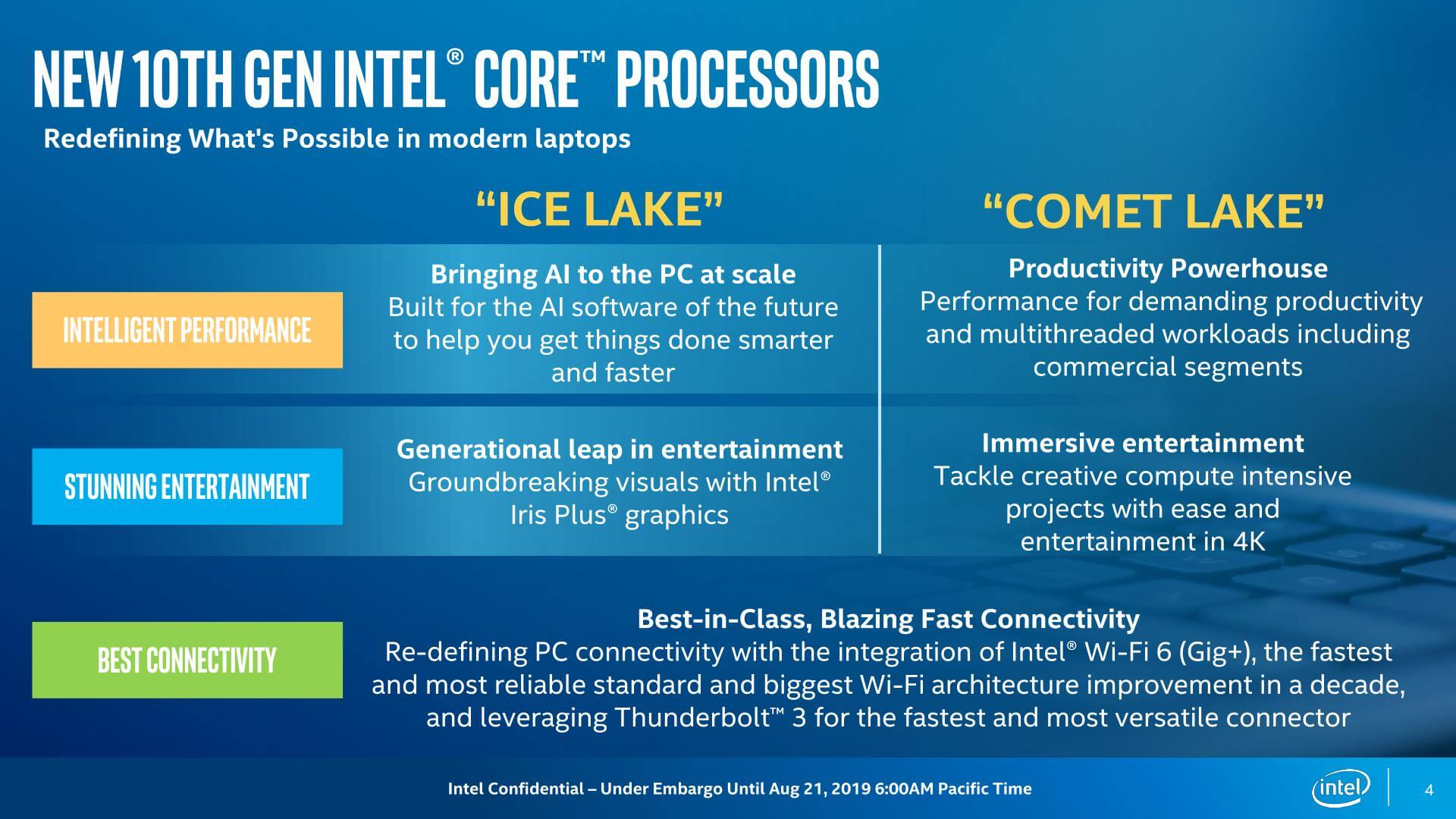
- Microsoft Surface Book Review
- Lenovo ThinkPad X100e Notebook Review
- Lenovo ThinkPad T510 Notebook Review
- Apple MacBook Pro with Retina Display Review
The other group of processors are Comet Lake, these are any other refinement of Skylake on 14nm. We're now not pretty sure what number of pluses we ought to upload to the give up there, but it’s virtually some now. Comet Lake brings no major updates to the microarchitecture or incorporated pix, however we do get quicker reminiscence and Wi-Fi 6 support.
Now, each product traces coexist within the same generation for the equal class of merchandise. Comet Lake consists of 15W U-series parts, while Ice Lake additionally has 15W elements, along with a few 9W and 28W models. So when buying an ultraportable laptop, essentially you’ll have a preference between Comet and Ice Lake relying at the version.
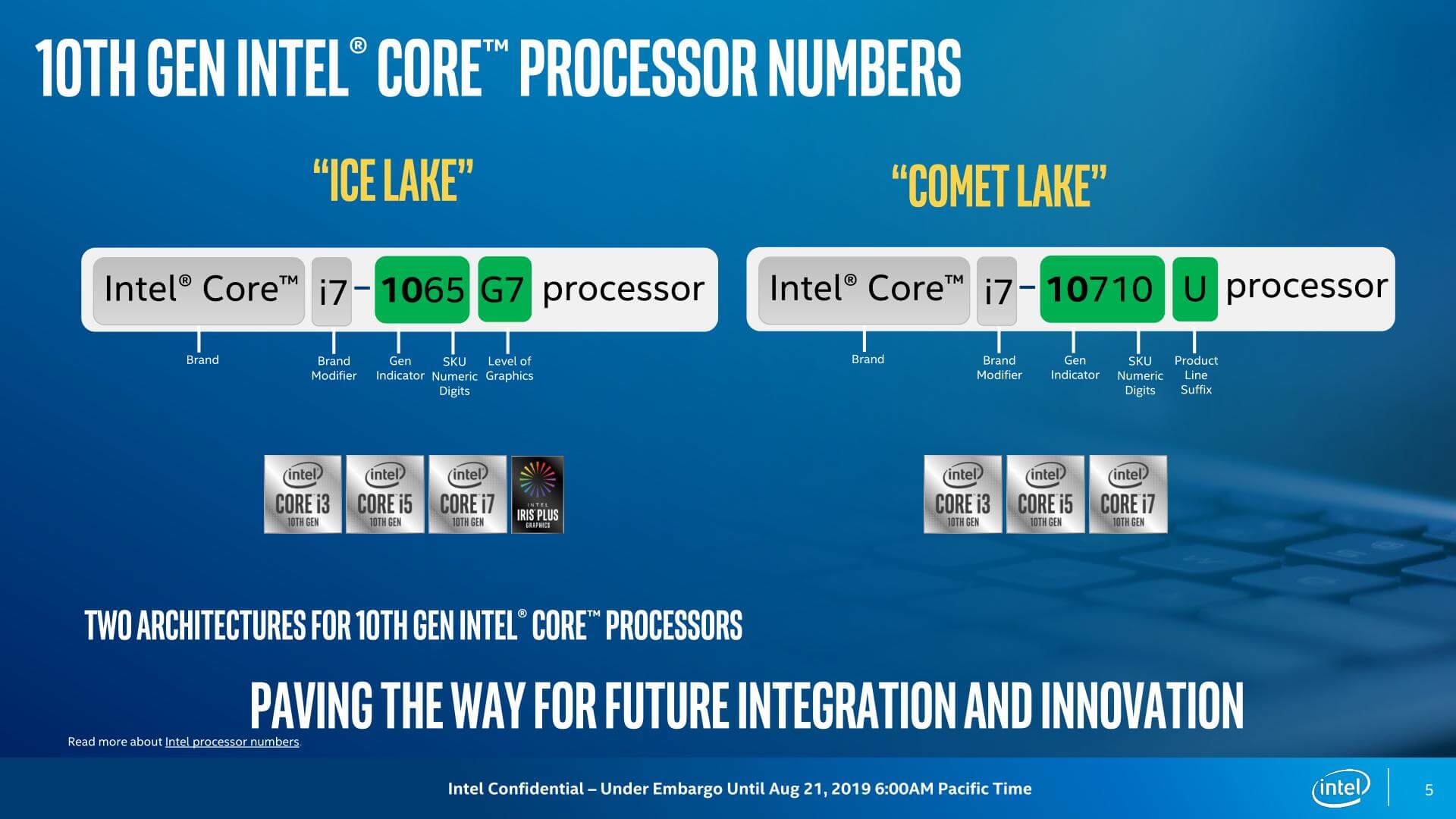
Each line of CPUs has its personal benefits. Ice Lake brings a big soar in integrated portraits overall performance, however it’s restrained to four CPU cores at modest clock speeds, topping out at three.9 GHz for the 15W fashions. Comet Lake has the equal crappy integrated pix we’ve had for generations, however with much higher CPU clock speeds (up to four.9 GHz) and a brand new six-middle configuration for the pinnacle-end Core i7. Indeeed, Intel has by hook or by crook managed to convey six cores into a 15W package.
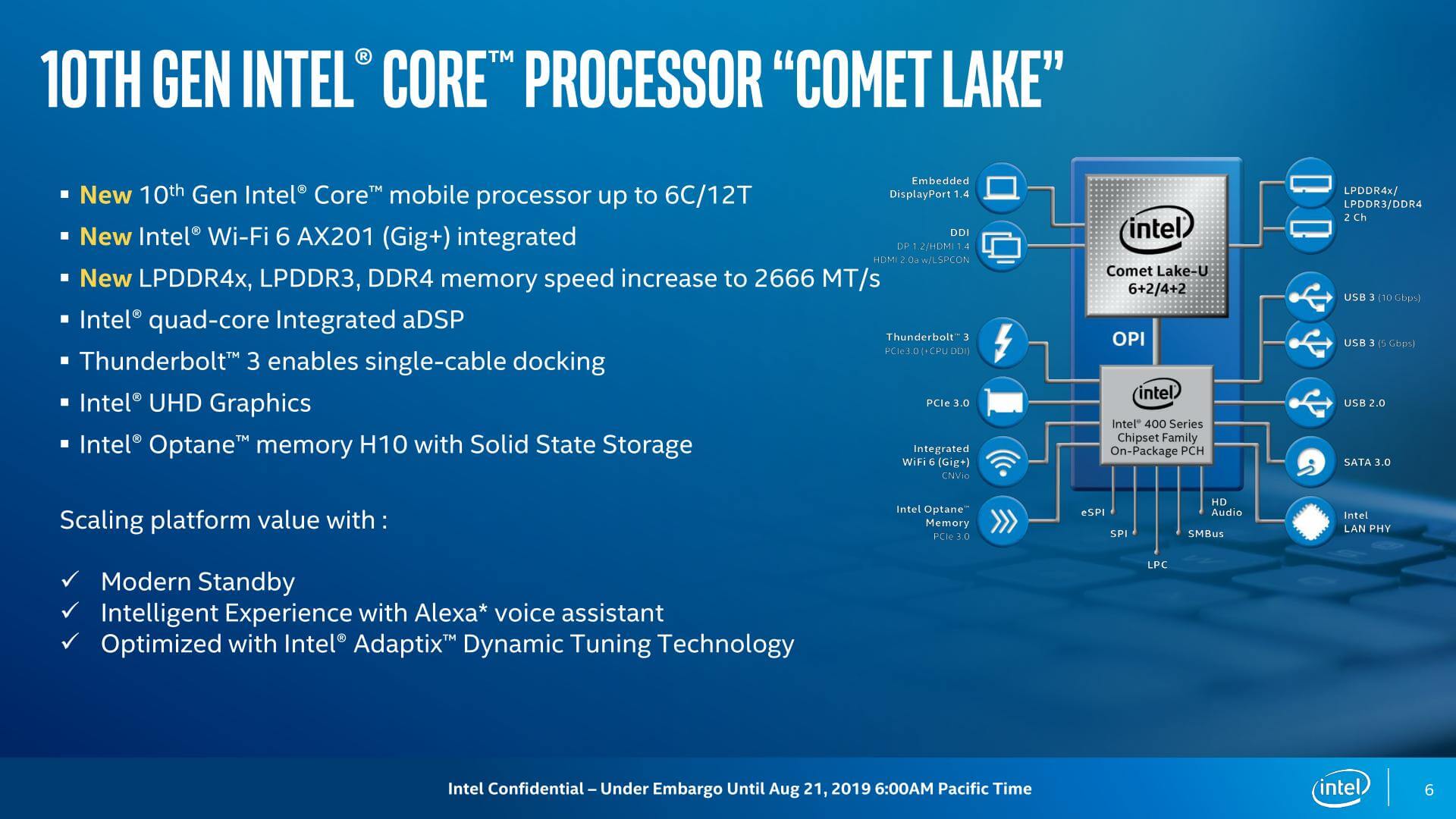
On paper, it looks like Comet Lake is the choice for the great CPU performance, and Ice Lake for GPU performance, however that is muddied by using some providers along with discrete GPUs, so it's no longer that simple.
The naming scheme is horrendous. Ice Lake processors are referred to as stuff like Core i7-1065G7 for the pinnacle-stop 15W Core i7, even as Comet Lake gets the similarly awful Core i7-10710U. Six letters or numbers for each processor’s version name is simply too many and for the average customer, how the are they supposed to inform what the difference is among a 1065G7 and a 10710U. These names need a massive simplification or a cut up into two line-u.s.a.to make the distinction extra obvious.
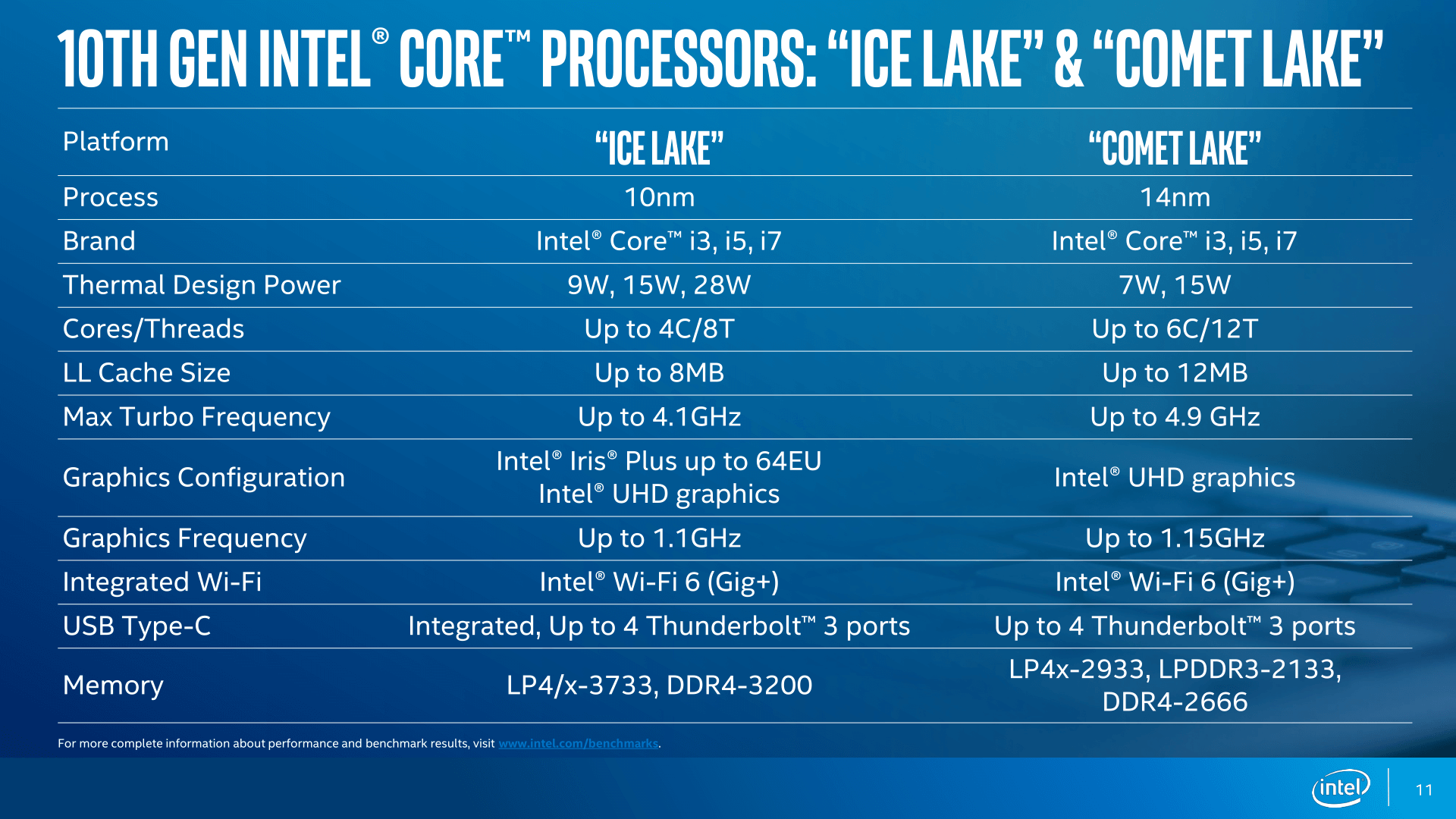
All that facts aside, we’ll be searching at Comet Lake first, after which hopefully in a few weeks while Ice Lake machines begin arriving to our labs, we will dive into that as well.
Now you is probably wondering, yet another 14nm product lineup isn’t that thrilling, but that’s no longer truely the case. Like with Kaby Lake Refresh that noticed a bounce from 2 to four cores for ultraportable laptops, and brought with it a overall performance boom, Comet Lake brings a jump from four to six cores.
At the moment this is simplest with one product in the lineup, the pinnacle end Core i7-10710U. Other Comet Lake CPUs, together with the Core i7-10510U and the Core i5s remain four cores, after which Core i3s and below are twin-cores. Today’s Laptopis a full benchmark breakdown of the Core i7-10710U, so we’ll be capable of see the advantages of bringing 6 cores into this kind of tight strength envelope, with a observe-up characteristic exploring how the Core i5 models step things up a notch, too.
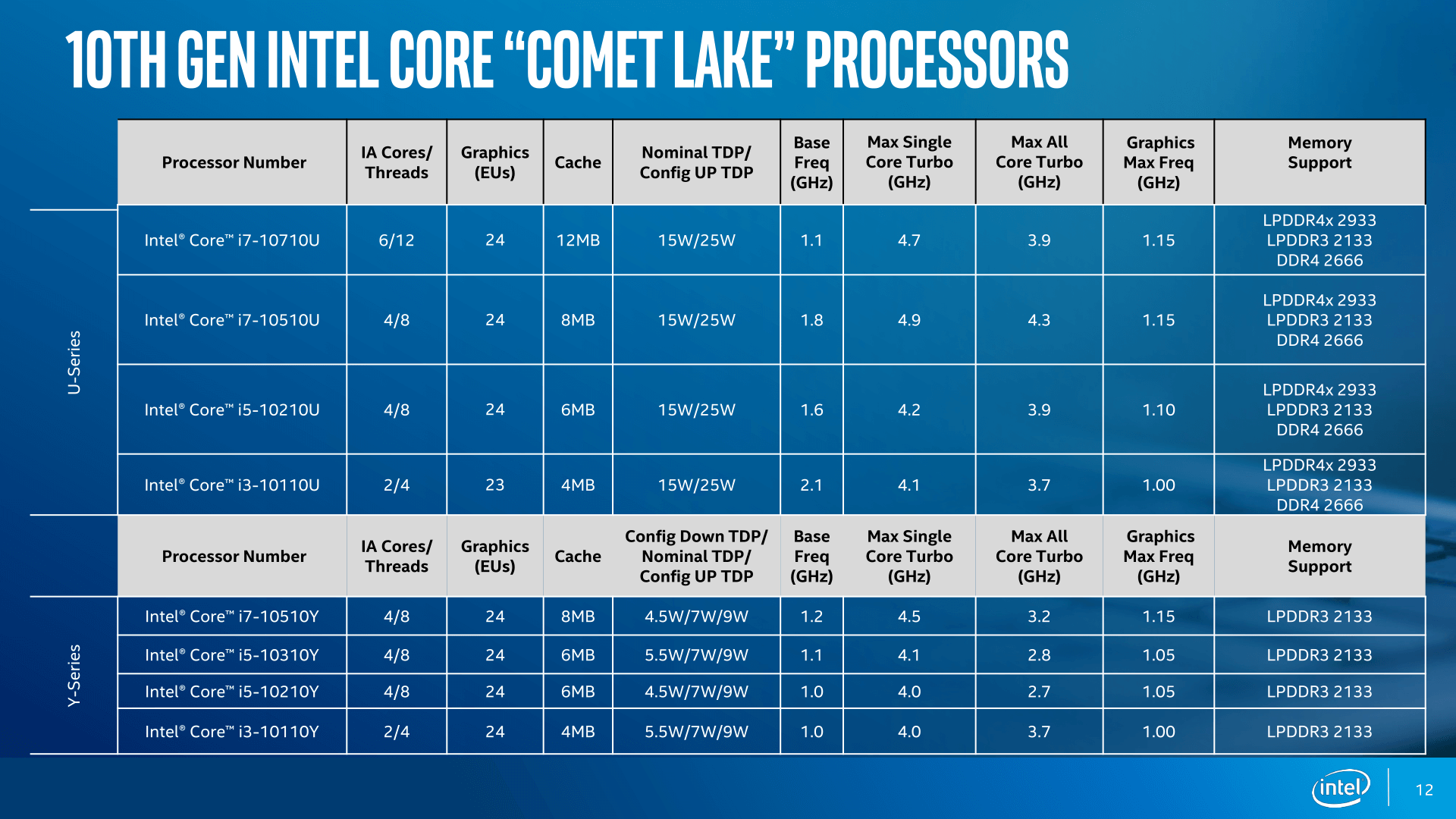
Compared to other Core i7s from the past few generations, the obvious headline function right here are the 6 cores and 12 threads, but to encompass this many cores inside the equal 15W TDP as preceding generations, clock speeds have needed to drop. The base clock now sits at 1.1 GHz compared to as high as 1.nine GHz with the Core i7-8665U, and boost clocks have additionally seen a moderate reduction from four.8 GHz within the previous gen, and four.nine GHz with the new Comet Lake quad-core choice.
What approximately all-center turbos? Intel doesn’t generally put it up for sale this, but we know the Core i7-8565U sits at 4.1 GHz on four cores. The Core i7-10710U hits three.nine GHz across six cores at its maximum, however it nonetheless does four.1 GHz on 4 cores, so we’re no longer losing anything in workloads that use the equal wide variety of cores. It’s simply the 10710U can also push out to six cores if vital, at lower clock speeds.
The other gain the six-center model brings is an increase to cache, now sitting at 12 MB, which fits Intel’s six-core Coffee Lake processors. However, there’s no upgrades to the GPU, so we’re getting every other UHD 620 with 24 execution gadgets and clock hurries up to 1150 MHz. This is a slow GPU, so don’t be surprised if many OEMs pair this CPU with a low-electricity discrete alternative like Nvidia’s MX250.
Testing Platform
The take a look at platform for nowadays’s benchmark is the MSI Prestige 14 A10SC. This high-quality neat pc packs the Core i7-10710U inner, while also featuring an Nvidia GeForce GTX 1650 Max-Q GPU and 16GB of twin-channel DDR4 memory, making for a powerful 14-inch slim and light device.
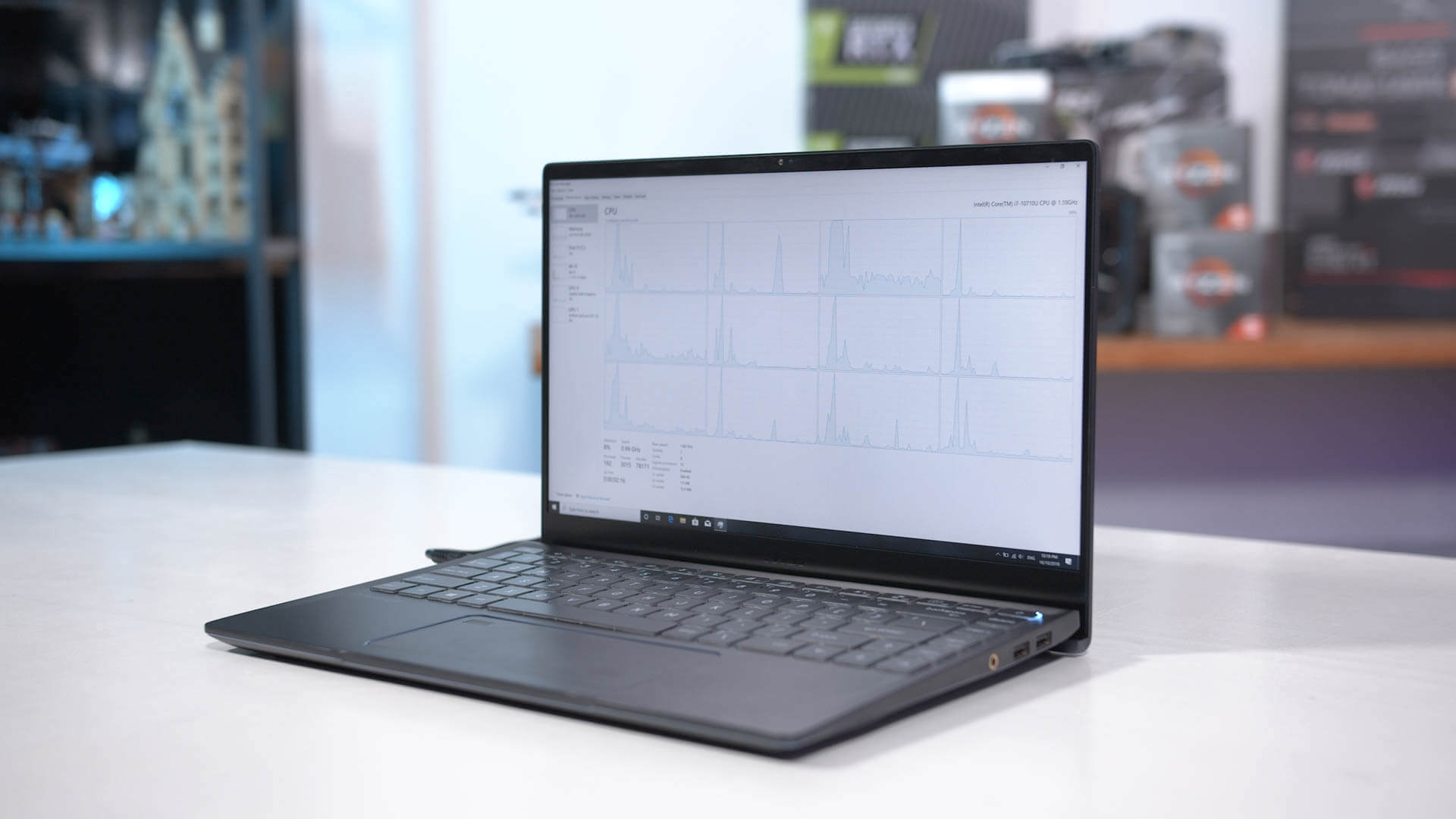
We got get admission to to an engineering sample in preference to a final retail version of the Prestige, meaning there are some early issues with this laptop that we anticipate might be resolved come the retail launch. But this isn’t a laptop review, we’re as an alternative targeted on how the 10710U plays.
Of word, there are some exclusive performance profiles. The “balanced” mode in MSI’s Creator app units this pc to the CPU’s default 15W configuration. That is 15W on the long time PL1 energy limit, and 45W at the PL2 limit. Using the "high overall performance" mode bumps this as much as the maximum 25W configuration: 25W PL1 and 51W PL2. These energy figures are similar to preceding technology laptops, so we’ll be able to draw a few comparisons.
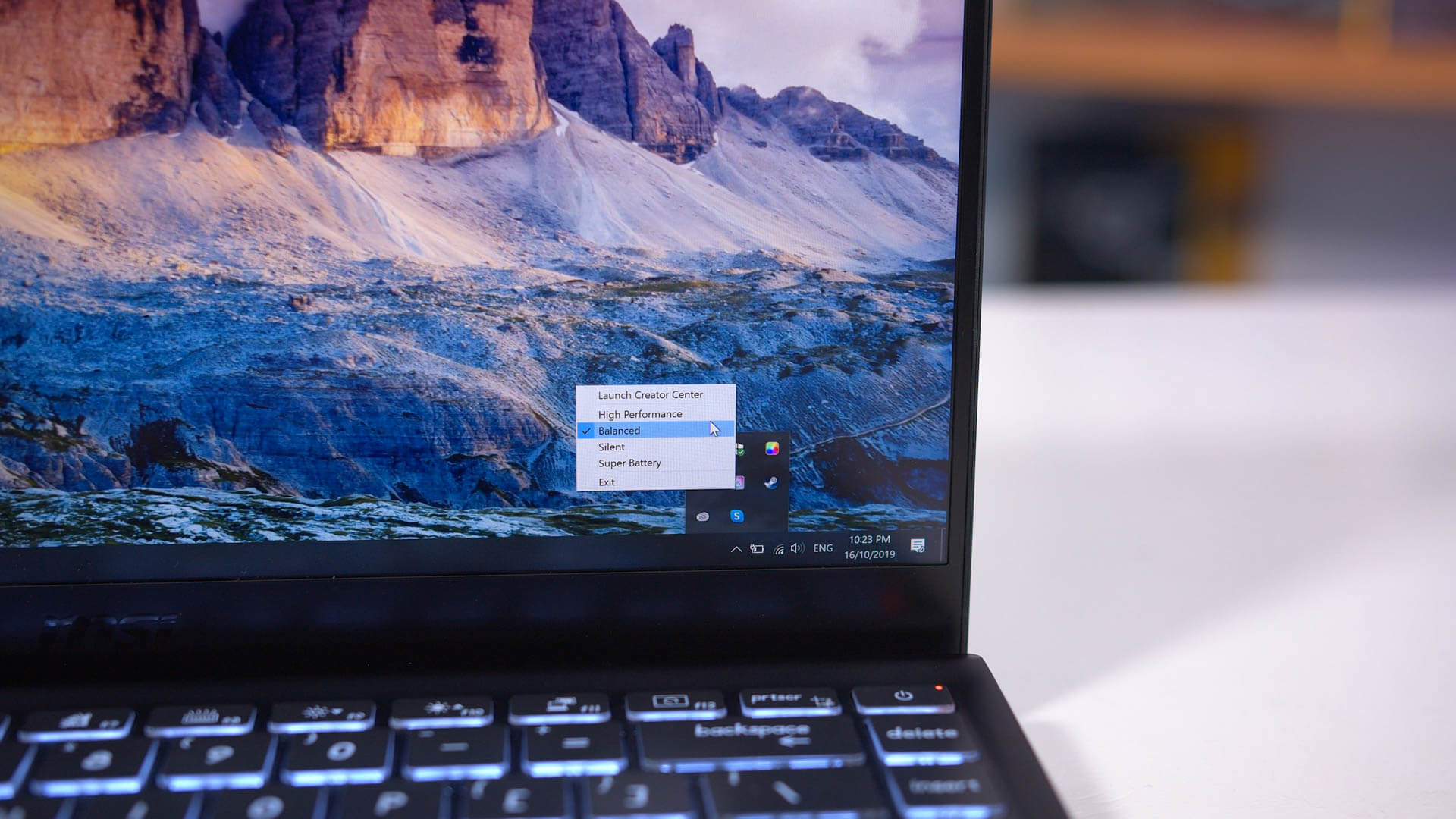
Turbo increase durations do fluctuate among laptops as every OEM can configure that personally, so there can be a few variance amongst models specifically for short term exams. But these numbers we’re approximately to go through need to still be representative of common i7 10710U overall performance, especially in longer workloads in which the CPU sits at its PL1 limit.
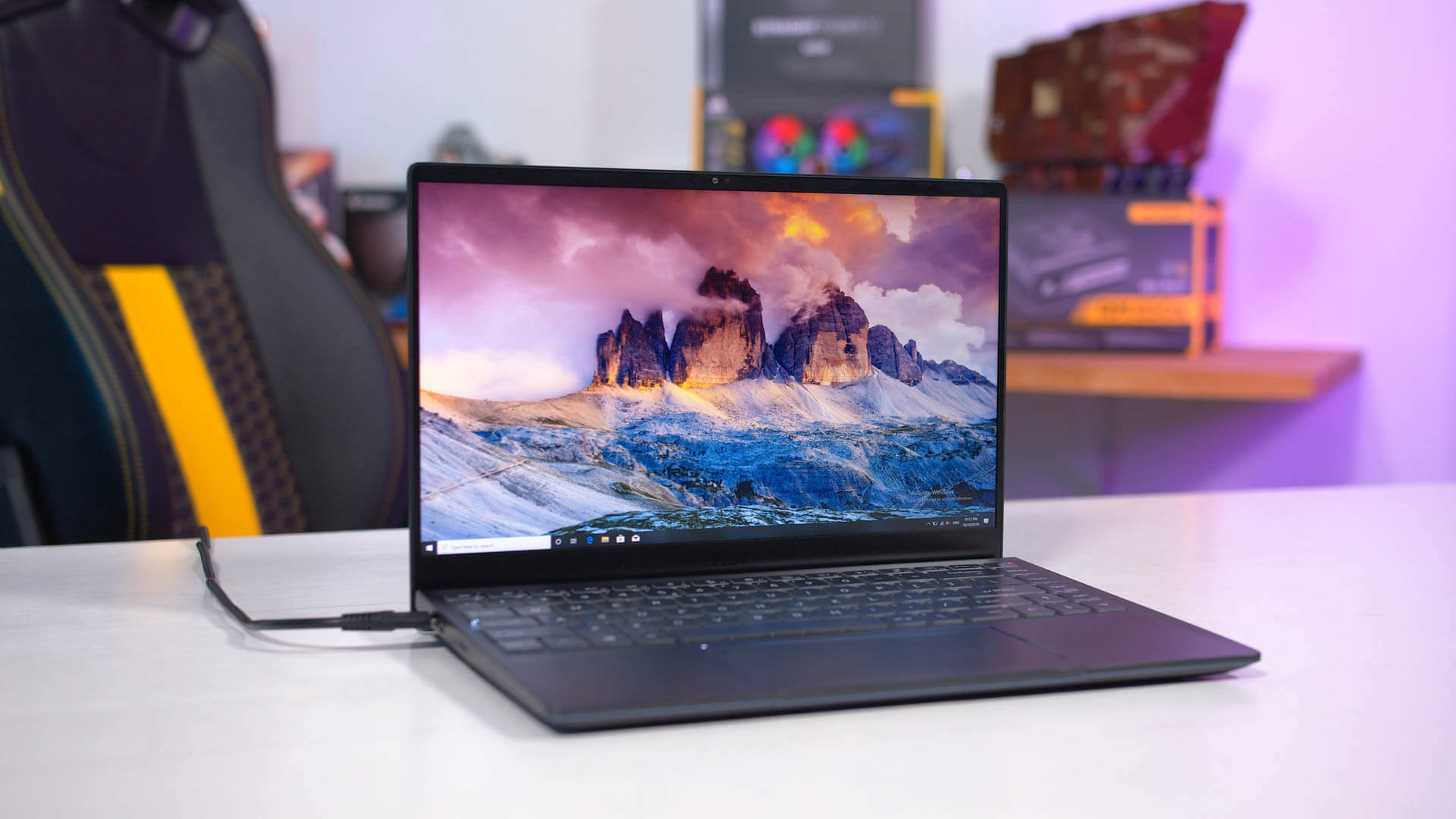
Because we’re totally targeted on CPU and iGPU performance on this assessment, we disabled the discrete GPU for these exams. The GTX 1650 Max-Q offers this laptop a big raise in compute or snap shots workloads however that’s no longer our situation right now.
Benchmarks
We’ll begin with something Intel has begged reviewers no longer to apply: Cinebench. While it’s true that you possibly won’t use a 15W laptop CPU to render 3D fashions, Cinebench is still a brilliant benchmarking platform to explore unmarried and multi-threaded overall performance and how that compares to different merchandise in the marketplace.
The Core i7-10710U posts a clearly outstanding rating inside the multi-threaded workload for just a 15W processor. It’s without problems the fastest 15W chip in this listing, coming in 33 percent faster than the Core i7-8565U. Yes, we have become 50% greater cores, but clock speeds had been decreased to healthy within 15W, so getting this extra performance bump is very decent.

You’ll also see the Core i7-10710U is most effective marginally behind the 35-45W quad-center Core i7-7700HQ from a few generations ago, and essentially equal to the 25W configuration of the Core i7-8565U. So despite the fact that Intel has been caught on 14nm in the 3 years since the launch of Kaby Lake, they’ve controlled to convey a similar degree of multi-threaded overall performance to a much decrease strength level with extra cores and optimizations.
Now you might be thinking, how is this feasible? Is Intel cheating the TDP and jogging out of doors 15W in long time workloads, like we’ve visible with desktop processors? The solution to this is no. As some distance as we are able to inform, the CPU does progressively drop all the way down to 15W for long term workloads. Certainly there has been a boost for quick time period workloads, which now deplete to 45W of power, however a good sized bite of Cinebench is capped inside the PL1 restrict.
The cause for this comes down to the non-linear nature of voltage-clock velocity curves. When you lessen clock speeds slightly, depending at the method node you can get giant upgrades to electricity intake.
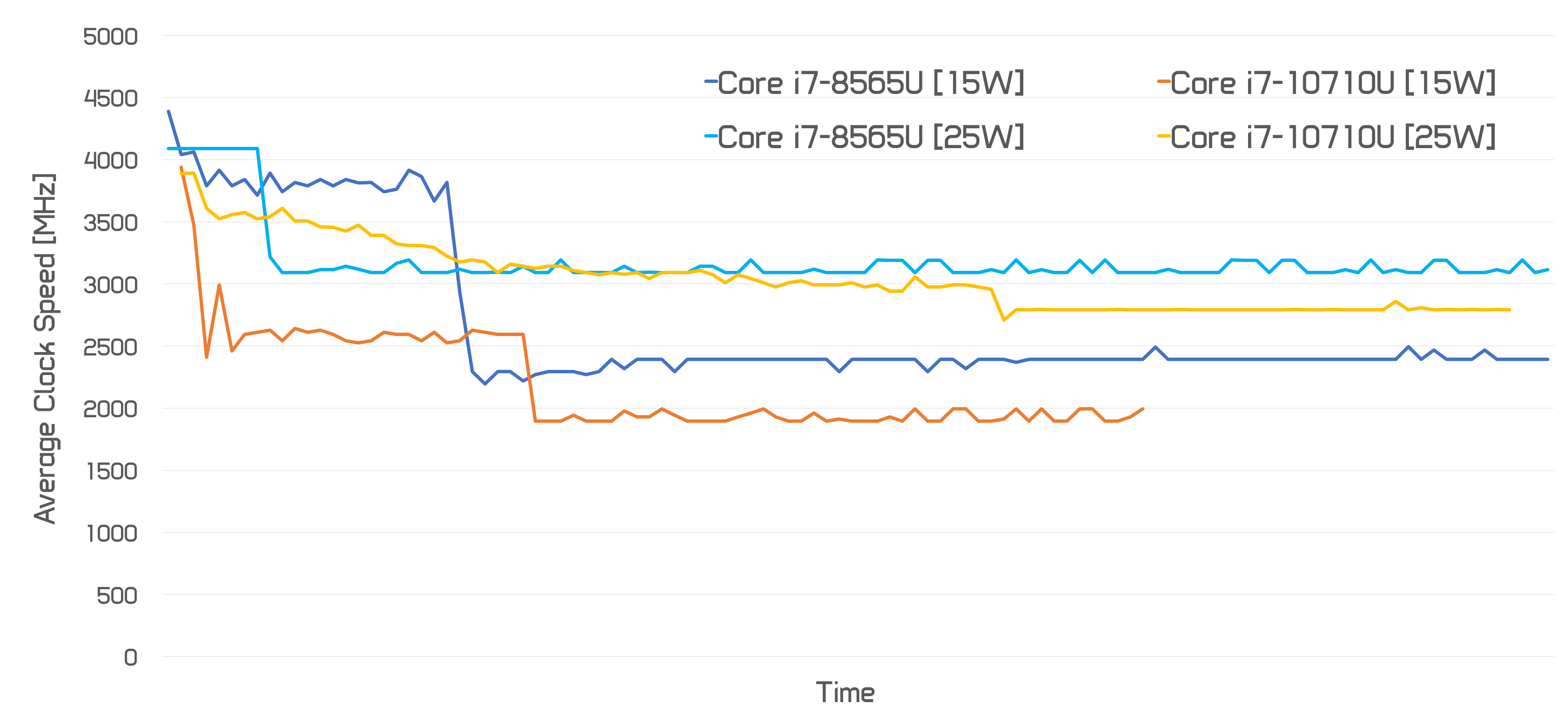
When looking at this clock velocity chart for Cinebench, you may see the i7-8565U runs at around 2.four GHz long term in its 15W configuration, or over three.0 GHz at 25W, throughout 4 cores. The Core i7-10710U runs at just 1.9 GHz at 15W across six cores, in order that’s 500 MHz decrease than the preceding-gen quad-cores, or extra than a GHz decrease comparing 15W to 25W.
Had Intel dropped their final-gen quad-core chip to 1.9 GHz, they’d get a massive drop in power intake. They’ve then used that freed up power price range to introduce greater cores, bringing the chip again up to 15W. The equation works out so well that the greater cores more than atone for the dropped clocks on this form of workload in phrases of performance, hence why we get greater overall performance at the identical electricity intake, clearly through expanded parallelization and walking these cores at greater efficient clocks.
You’ll note some different matters from this Cinebench chart. Single-thread overall performance is around the equal mark comparing tenth-gen to 8th-gen, because unmarried middle turbo frequencies are approximately the same. At 25W, we also see a large overall performance advantage over the Core i7-8565U, however we’re no longer at the level of the 45W six-center Core i7-8750H or i7-9750H. Those beefed up chips with higher strength limits are 18% quicker, so that you can see the 25W 10710U is greater green however it simply can’t healthy the performance of these better-stop chips.
Adobe Photoshop Iris Blur is an effect that’s in the main CPU, cache and memory restricted. We’re handiest seeing modest profits for the 10710U over the 8565U, to the tune of ~10% that is a piece decrease than we’ve seen from different, extra extensive checks. There’s also much less of a bonus from moving to Intel’s better TDP six-middle CPUs, although the advantage is still there.

Photoshop’s Smart Sharpen filter goes the opposite way, and turns into GPU constrained. Given we aren’t getting some thing new with the UHD 620 GPU, it’s no surprise to peer the Core i7-10710U matching different 15W processors.

MATLAB is a workload that isn’t depending on some thing but memory and cache, so right here we don’t see lots movement or improvement in performance. Comet Lake does assist LPDDR4x however our laptop check machine is still using DDR4.

Before we wrap this up, right here's any other look at GPU performance. Without any development to the incorporated GPU we aren’t seeing an improvement to CompuBench compute overall performance in optical drift. Adding something like an MX150 is essential for respectable GPU overall performance.

Performance Summary
We’ll start with a era on technology appearance with the Core i7-10710U as opposed to the Core i7-8565U of their 15W configurations. Performance here does vary a bit relying on whether or not the benchmark is multi-threaded or unmarried-threaded, but in widespread we’re searching at a 25 to 30% improvement in multi-threaded performance going from four to six cores. That’s quite high-quality with the sort of tight strength limit.
Core i7-10710U vs Core i7-8565U

Single-core gains are nearly non-existent broadly speaking because the CPU middle architecture itself is unchanged from previous generations, and at the least with this six-middle design, we aren’t getting an improvement in boost clocks. Not that the CPU even reaches the raise clock in longer unmarried-middle workloads, due to the fact there genuinely isn’t sufficient power budget to do so. At the absolute quality we’re getting 2-three% extra overall performance, and we’d say that’s all down to manner optimizations and binning.

The integrated GPU is likewise unchanged, so once more no overall performance profits there. This is important for workloads like Premiere which depend upon GPU acceleration. We expect masses of designs to pop out with discrete GPUs – the MSI Prestige 14 has a GTX 1650 Max-Q as an example – a good way to provide a respectable boost to GPU horsepower.

When evaluating 25W fashions, it’s a comparable tale, without as tons of a benefit in single-threaded workloads. Here the six-center may even be slower in some situations, but we’re nevertheless getting that ~30% development in multi-threaded workloads.
If you’re wondering approximately 15W as opposed to 25W, well in case you’re fortunate enough to get a pc that may be run at 25W, you’re looking at a decent 30% advantage in a few workloads, or extra modest single digit gains in others. Given long time electricity intake is 40% better with the cTDP Up configuration we’re transferring faraway from the efficiency sweet spot, but for a few, the more overall performance is all that topics.
Core i7-10710U vs. Core i7-7700HQ vs. Core i7-9750H
These subsequent comparisons are a number of the most interesting in my view. The i7-10710U at 15W isn’t that a ways off the i7-7700HQ in maximum workloads. Performance isn’t quite equal, but Intel has been able to facet closer to replicating 45W performance from 3 years in the past with a 15W chip, with none main leaps in method tech. People love to snort at 14nm++ and that is sort of genuine at the desktop, but in those electricity optimized CPUs, it seems to be making a piece of a distinction while Intel can add more cores into the mixture as nicely.

Intel hasn't reached the point in which their 25W U-series chip can compete with 45W H-collection models. The i7-9750H continues to be 30% faster or so in important workloads like video encoding, so don’t move ditching your 15-inch H-series pc just yet because a six-core U-collection CPU doesn’t stack up as expected.

Core i7-10710U vs. Ryzen 7 3750H
The launch of Comet Lake isn’t correct news for AMD. The Core i7-10710U is, in our opinion, a far better alternative than even the Ryzen 7 3750H, and we’re talking approximately a 15W CPU vs 35W right here. These CPUs exchange blows, no matter the 3750H proposing tons better electricity necessities, and impressively the 10710U even beats it in workloads like Handbrake and specially whatever unmarried threaded. The best benefit the 3750H has is a much quicker included GPU, but that can disappear easily with a discrete GPU pairing, that is becoming greater commonplace.

It’s even worse whilst you deliver the Core i7-10710U a bit more power to play with. Ryzen receives badly overwhelmed right here, and we’re no longer even comparing U-series to U-collection that's even extra of a bloodbath. AMD can’t get Zen 2 primarily based designs here speedy sufficient, where we count on the significant adjustments to architecture and the introduction of 7nm to bring massive gains inside the low energy area.

Wrap Up
Seeing Intel attain the bounds in their 14nm manner, we sincerely weren’t awaiting the Core i7-10710U to be this true. At 15W we occur to be proper within the candy spot for an efficient six center design, which lets in for as much as 30% greater overall performance in multi-threaded workloads. We aren’t getting many other enhancements, however for shoppers of ultraportable structures and with the growing utilization of multi-threading, that is very respectable.
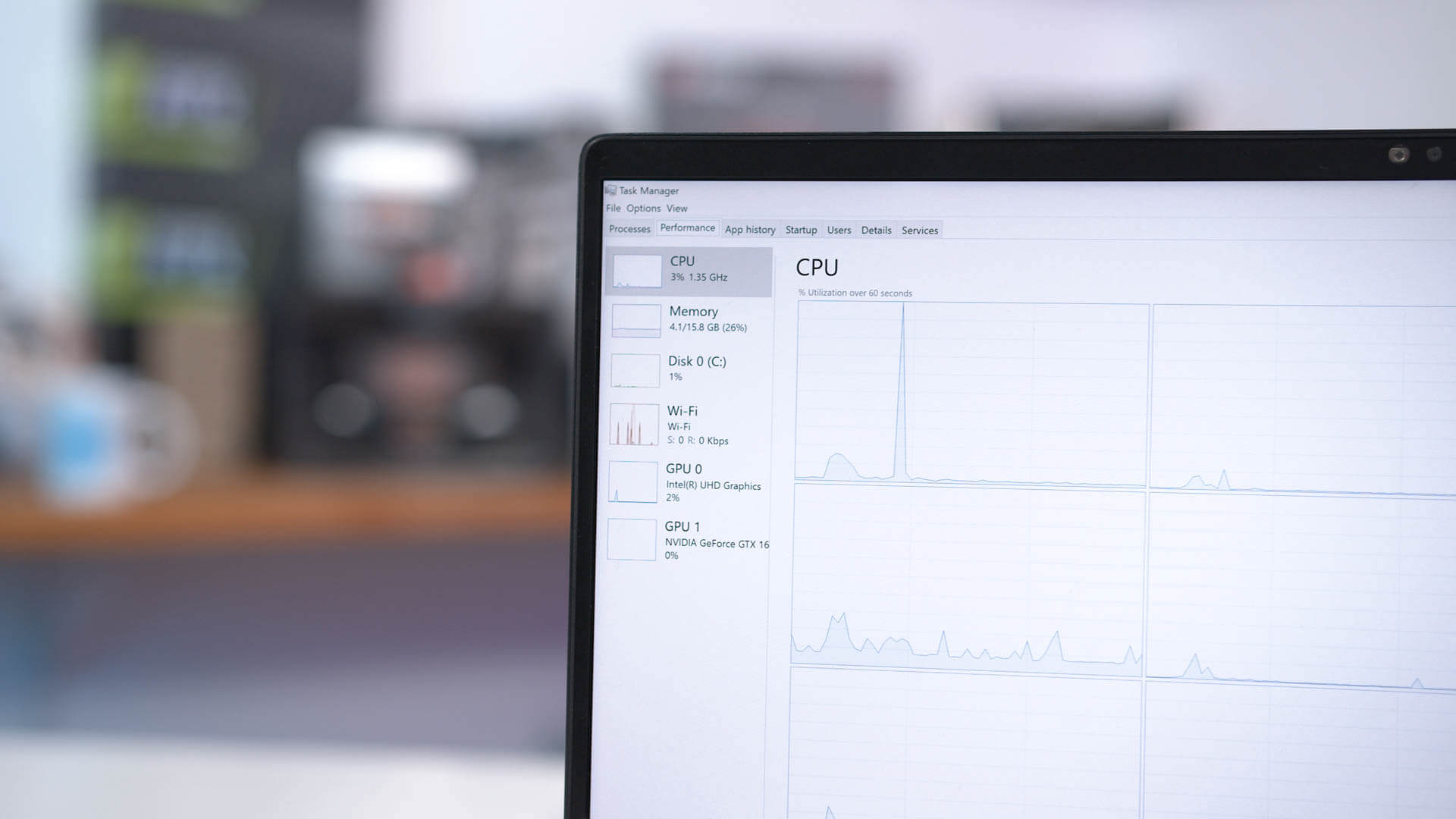
Anyone seeking to upgrade their narrow and mild machine should be able to find performance gains even over a quad-core from the beyond few generations, even though you’ll have to particularly search for a Core i7-10710U as it’s the simplest six-core version. If you’re coming from a dual-core, you’ll be blasted into a new dimension with all the more overall performance you’ll get. Seriously, those twin-core Intel U-collection processors are gradual these days.
It’ll be thrilling to see how Ice Lake stacks up. We realize they're clocked decrease, but given U-collection chips normally hover inside the mid 2 GHz variety with 4 cores, this could not be a problem. And the advanced integrated pictures may come handy, however they could additionally end up easily outpaced with the aid of a Comet Lake CPU with a discrete GPU, like is determined in this MSI Prestige notebook. Time will inform.
Shopping Shortcuts
- Core i7-10710U Laptops on Amazon
- Core i7-8565U Laptops on Amazon
- Core i7-10510U Laptops on Amazon
- Ryzen 7 3700U Laptops on Amazon
- Ryzen 7 3750H Laptops on Amazon
Further Reading
- The Best Laptops 2019
- Reasons to Upgrade Your Laptop (That Go Beyond a Performance Upgrade)
- Desktop vs. Laptop Gaming with the RTX 2070
0 Response to "Intel Core i7-10710U Benchmarked: 14nm+++ Comet Lake"
Post a Comment